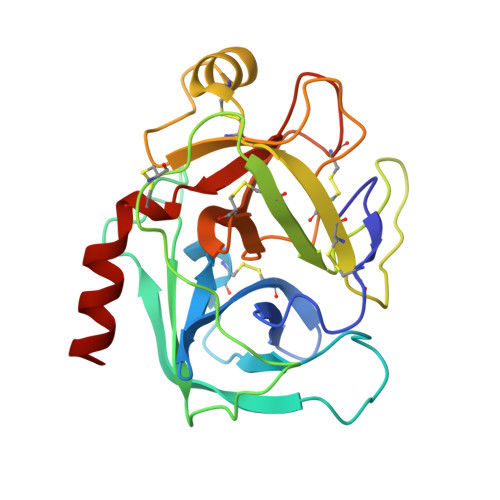Compromise and accommodation in ecotin, a dimeric macromolecular inhibitor of serine proteases.
Gillmor, S.A., Takeuchi, T., Yang, S.Q., Craik, C.S., Fletterick, R.J.(2000) J Mol Biol 299: 993-1003
- PubMed: 10843853
- DOI: https://doi.org/10.1006/jmbi.2000.3812
- Primary Citation of Related Structures:
1EZS, 1EZU - PubMed Abstract:
Ecotin is a dimeric serine protease inhibitor from Escherichia coli which binds proteases to form a hetero-tetramer with three distinct interfaces: an ecotin-ecotin dimer interface, a larger primary ecotin-protease interface, and a smaller secondary ecotin-protease interface. The contributions of these interfaces to binding and inhibition are unequal. To investigate the contribution and adaptability of each interface, we have solved the structure of two mutant ecotin-trypsin complexes and compared them to the structure of the previously determined wild-type ecotin-trypsin complex. Wild-type ecotin has an affinity of 1 nM for trypsin, while the optimized mutant, ecotin Y69F, D70P, which was found using phage display technologies, inhibits rat trypsin with a K(i) value of 0.08 nM. Ecotin 67-70A, M84R which has four alanine substitutions in the ecotin-trypsin secondary binding site, along with the M84R mutation at the primary site, has a K(i) value against rat trypsin of 0.2 nM. The structure of the ecotin Y69F, D70P-trypsin complex shows minor structural changes in the ecotin-trypsin tetramer. The structure of the ecotin 67-70A, M84R mutant bound to trypsin shows large deviations in the tertiary and quaternary structure of the complex. The trypsin structure shows no significant changes, but the conformation of several loop regions of ecotin are altered, resulting in the secondary site releasing its hold on trypsin. The structure of several regions previously considered to be rigid is also significantly modified. The inherent flexibility of ecotin allows it to accommodate these mutations and still maintain tight binding through the compromises of the protein-protein interfaces in the ecotin-trypsin tetramer. A comparison with two recently described ecotin-like genes from other bacteria suggests that these structural and functional features are conserved in otherwise distant bacterial lineages.
Organizational Affiliation:
Graduate Group in Biophysics, University of California, San Francisco, CA, 94143-0448, USA.
















